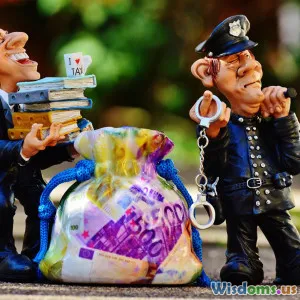
Insider Trading Unveiled How Savvy Brokers Skirt the Law and Profit
10 min read An in-depth exploration of insider trading, revealing how brokers circumvent laws to profit illicitly. (0 Reviews)
Insider Trading Unveiled: How Savvy Brokers Skirt the Law and Profit
Insider trading is one of the most contentious issues in financial markets. It conjures images of shadowy deals and swift fortunes gained by those with privileged information. But beneath the surface lies a complex web of legal nuances, enforcement challenges, and market consequences. This article unpacks the mechanisms by which some brokers exploit inside knowledge to beat the system—and how regulators strive to keep pace.
The Lure of the Insider Trade
Picture this: a stockbroker overhears confidential information about an upcoming merger that will likely skyrocket a company’s stock price. Acting on this intelligence, the broker makes substantial trades before the news breaks, reaping enormous profits while everyday investors remain in the dark. The allure of insider trading lies in its potential for quick, presumably risk-free gains—turning private information into financial gold.
However, it’s illegal for a reason. It distorts the level playing field that markets depend on, undermines public trust, and can lead to devastating financial consequences for those left on the outside.
Defining Insider Trading: Legal vs. Illegal Practices
Not all insider trading is illicit—there is a legal framework governing what may be traded and when.
Legal insider trading occurs when directors, officers, or employees buy or sell stock in their own companies, reporting transactions to regulatory bodies like the U.S. Securities and Exchange Commission (SEC). These transactions are done transparently and without exploiting nonpublic information that gives unfair advantage.
Illegal insider trading, by contrast, involves using material, nonpublic information for personal gain or tipping others who trade on that information. For example, a broker who learns about a company’s earnings ahead of time and trades on that intelligence is engaging in illegal conduct.
Judge Learned Hand once succinctly described illegal insider trading as the "misappropriation of information in breach of a fiduciary duty or other relationship of trust and confidence," emphasizing the violation of trust rather than just the act of trading.
Tactics of Savvy Brokers: How Insider Trading Happens
Savvy brokers employ clever techniques to skirt laws and obscure their tracks:
1. Insider Networks and Tipping
Brokers often do not act alone. They receive 'tips' from corporate insiders, lawyers, or consultants who possess unpublished information. For instance, during the infamous Raj Rajaratnam insider trading case (Galleon Group, 2009), the hedge fund founder was convicted due to information flowing through a network of insiders and brokers.
2. Pyramiding Trades and Use of Straw Accounts
To avoid immediate detection, brokers might use multiple accounts, including those held by family or third parties, to execute trades. This diffuses responsibility and complicates tracking. These shell accounts help mask the illegal sources of information.
3. Sophisticated Timing Strategies
Trades are timed just before essential announcements like earnings reports, mergers, or government approvals. The incredible precision signals an illicit connection to nonpublic intel.
4. Utilizing Algorithms and Dark Pools
Modern technology allows brokers to execute trades through dark pools—private exchanges inaccessible to the public—where trades aren’t immediately visible. Coupled with algorithms programmed to identify optimal buy/sell moments, insiders exploit real-time information stealthily.
Case Studies That Shook the Market
The Martha Stewart Saga
In 2001, celebrity Martha Stewart was accused of insider trading due to her selling of ImClone Systems stock following non-public information about FDA decisions. Though she was convicted on charges related to obstruction rather than insider trading directly, the case brought high-profile attention to insider misconduct.
The Galleon Group Scandal
Raj Rajaratnam’s hedge fund systematically traded on privileged information from company insiders and brokers, generating profits exceeding $60 million before being caught. The FBI's wiretaps and insider cooperation revealed a prolific insider network, showcasing how large and intricate these schemes can be.
SAC Capital Advisors
Led by Steven A. Cohen, SAC Capital was embroiled in insider trading probes resulting in a $1.8 billion fine. This highlighted how organizations with massive capital and sophisticated systems could still engage in unethical trading.
Regulatory Challenges in Detecting Insider Trading
The Complexity of Proof
Prosecutors must demonstrate that the accused knowingly used material, nonpublic information with intent to defraud. This high bar makes many insider trading cases difficult to prove.
Rapid Market Movements
High-frequency trading and global market integration complicate tracing suspicious trades. Transactions occur rapidly, often in milliseconds, demanding advanced surveillance tools.
Legal Ambiguity
Certain actions can be borderline—such as obtaining information through lawful means but using it earlier than others—leading to protracted legal debates about what is deemed 'inside information'.
Enforcement Agencies and Technological Advancements
The SEC and Department of Justice employ data analytics, predictive algorithms, and surveillance of communication channels (emails, calls) to uncover illicit activity. For instance, the SEC’s Market Abuse Unit has flagged suspicious patterns to initiate investigations.
Consequences and Ethical Impacts
Impact on Investors and Markets
When insider trading thrives, ordinary investors lose confidence, markets lose efficiency, and the true risks get obscured. Price manipulation can lead to bubbles or crashes.
Legal Repercussions
Punishments include hefty fines, disgorgement of profits, imprisonment, and lifetime bans from the securities industry. The fear of such consequences acts as a deterrent, but enforcement is not always consistent.
Moral and Corporate Culture
Beyond legality, insider trading corrodes ethical standards within financial institutions. To combat this, many firms create robust compliance departments and ethics training programs.
How Investors Can Protect Themselves
While individual investors cannot access the same depth of information as insiders, awareness is key:
- Understand that consistently high, risk-free returns are suspicious.
- Follow regulatory announcements of insider trading cases to recognize patterns.
- Opt for investment in funds with strong governance and transparent practices.
- Advocate for market transparency and robust regulatory oversight through shareholder engagement.
Towards a Fairer Market: Future Outlook
Technology and data analytics continue to evolve, giving regulators improved tools to detect and deter insider trading. Blockchain and distributed ledger technologies hold promise for enhancing transparency.
Educational efforts have raised awareness, but as schemes become more layered, ongoing vigilance and legal clarity are essential.
International cooperation also plays a pivotal role, as insider trading often crosses borders.
Conclusion
Insider trading remains a persistent challenge that tests the integrity of financial markets globally. Savvy brokers exploit legal gray areas and technology to profit illegally from confidential information, undermining investor confidence and fair play.
Through high-profile prosecutions, technological advances, and increased public awareness, there is hope for curbing abusive practices. Yet, the battle is ongoing, requiring cooperation between regulators, financial institutions, and investors to uphold the principles of justice and equity in the markets.
Ultimately, understanding insider trading’s mechanisms not only educates but also empowers stakeholders to advocate for a safer, more transparent financial ecosystem.
References:
- U.S. Securities and Exchange Commission. Insider Trading and Corporate Fraud.
- United States v. Rajaratnam et al., 2011.
- The Galleon Group Insider Trading Conspiracy, Department of Justice press releases.
- FCA Handbook, UK Financial Conduct Authority.
- Bhattacharya, U., Daouk, H. (2002). The World Price of Insider Trading. The Journal of Finance.
- Stanford Law Review, "The Ethics of Insider Trading," 2016.
Rate the Post
User Reviews
Popular Posts


















